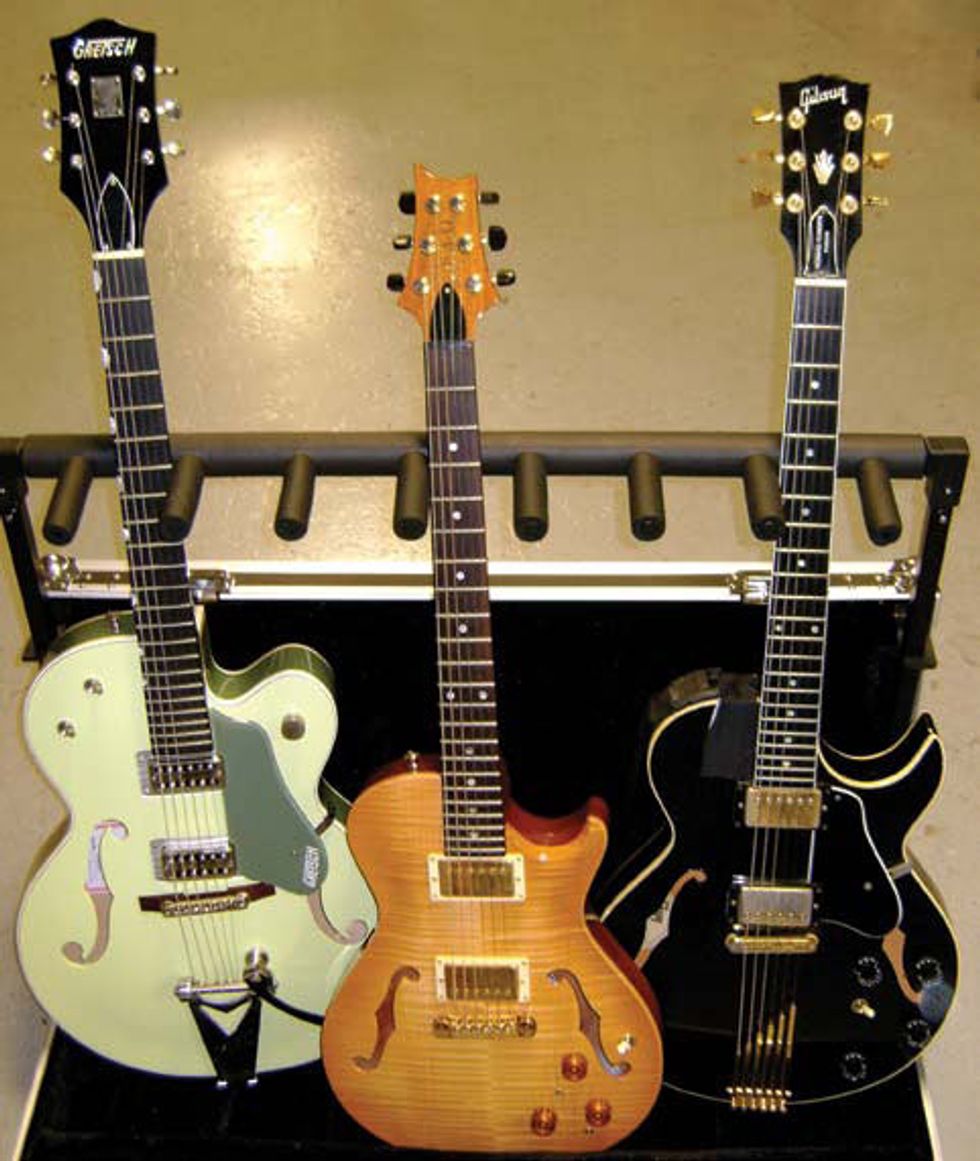Certain guitar models often get associated with specific genres of music and become the visual association for that genre. When most of us see a Telecaster, we think of chicken pickin’ and country music. On the same theme, it’s difficult to see a big orange Gretsch 6120 and not think of rockabilly music. While these examples are broad generalizations, there are many exceptions to the tonal clichés of a specific guitar model. Many people seem to associate hollow guitars with jazz, but if you listen to the gritty tones that Dave Grohl gets out of his Gibson DG-335 or the powerful rock tones that scream out of Ted Nugent’s Byrdland, then a broader tonal palette beyond smooth, warm jazz tones becomes evident in hollow guitars. I own several different hollow guitars, but there are three that I am going to focus on, along with their unique, respective tones: a Gretsch 6118T-LTV, a PRS Hollowbody 1, and a Gibson Howard Roberts Fusion III.
Gretsch 6118T-LTV: This guitar was briefly featured in my March Tone Tips column [“Covering the Tonal Bases,”March 2011] where I mentioned the importance of a pinned Tune-o-matic bridge on Gretsch guitars. Most Gretsch guitars, like this one, have a tone selector that is sometimes referred to as a “mud switch.” For any type of “regular” guitar playing, I usually do not have the tone selector engaged. In fact, I’ve seen several players have their tone selector completely removed from the electronics altogether. However, I’ve found a useful sound using the tone selector that is great for padding a song with a keyboard-like effect. To do this, set the tone selector to the bass setting and engage a rotary effect and a delay. Set the delay’s mix low and dial in four to five repeats. The tone selector covers up most of the attack from your pick and the delay paired with the rotary creates a lush, non-guitar sounding tone that’s great for playing chords.
Feedback suppression technology has come a long way from the days when Les Paul would stuff his hollow guitars with socks and towels in an attempt to tame feedback. When it comes to Gretsches, I prefer the models that sport the 1959 trestle bracing because it helps reduce feedback issues. The trestle bracing also gives the guitar a feel and response that’s more like a solidbody, which I like. To further travel down the road of giving my Gretsch a more solid-like feel, I put a piece of foam under the strings in the area behind the bridge. This helps cut down on some of the high-pitched overtones that sometimes sneak over the bridge and into the pickups. If I’m doing Bigsby-intensive playing, I’ll remove the foam and let those overtones add to the overall character of the sound.
PRS Hollowbody 1: I mainly use this guitar for plugged-in, acoustic-based guitar tones. I have the action set higher than most of my other electric guitars and string the instrument with SIT Power Wound .011s with a wound 3rd string, which has a more stable feeling and a meatier sound. To combat thin and anemic tones, which can often appear when using most piezo pickups, I use heavier strings to add body and vitality to the sound. One of the special tones I’ve found on this guitar involves using all three pickups. Blending the piezo transducer with the PRS 245 neck and bridge pickups delivers an unusual tone that is reminiscent of Django Reinhardt’s Gypsy jazz sound when he picked close to the bridge. Adding a piezo system to any electric guitar is a great way to open up a new universe of tonal possibilities.
Gibson Howard Roberts Fusion III: Musicians often ask each other questions like, “If you could only have one guitar, what would it be?” Well, for a long time, my Howard Roberts was the only electric guitar I used, both in the studio and on the road. Don’t be fooled by this guitar’s jazzy looks because some of the best tones I can pull out of this guitar are rock and Tele-esque sounds. The guitar’s top, back, sides, and neck are all made from maple, which is a very bright and crisp wood. To further enhance the guitar’s already bright tone, the guitar is strung with a .0095-gauge set of strings. The lighter strings allow me to easily get a bright, snappy attack and I let the guitar’s hollow chambers fill in my tone’s low end to round out the sonic character. This guitar has a center block running down the middle of the body, which greatly reduces feedback when I have my amp cranked. However, if I want to use feedback to my advantage to add sustain to notes during a solo, I’ll move to different points onstage during soundcheck to find the best amp-to-guitar proximity for maximum wailing. I make mental notes of those “feedback zones” and use them accordingly throughout the show.
Whenever you’re playing a guitar and you come across a tonal setting that seems unusable, stop for a moment and think about an application where that tone might sound good. Is there an effect you can stack on top of that “unusable” tone and turn it into a cool sound? This type of thinking can take you on a unique sonic voyage, which can lead to some original and inspiring music.







![Rig Rundown: Russian Circles’ Mike Sullivan [2025]](https://www.premierguitar.com/media-library/youtube.jpg?id=62303631&width=1245&height=700&quality=70&coordinates=0%2C0%2C0%2C0)


























